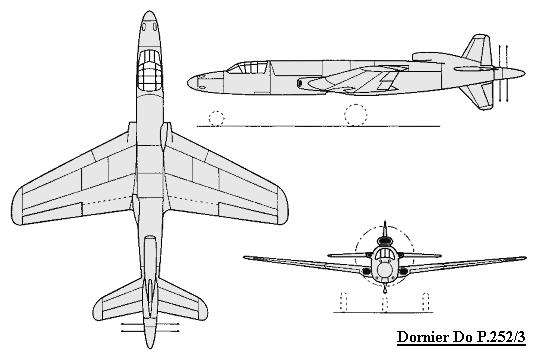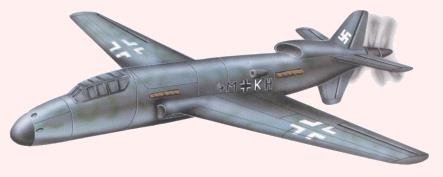| Type | Do 252/3 2-seat night fughter |
| Engine | 2 Junkers Jumo 213J or 2 Daimler-Benz DB 603LA with 3-bladed vVDM variable pitch propellers , dia. 3,2 m. Could be blown off in an emergency |
| Dimensions | Length 17,2 m , height 5,05 m , span 15,8 m , wing area 50 m2 . ( Do 252/I Length 15,2 m , height 4,95 m , span 16,4 m , wing area 43 m2 ) |
| Weights | Empty 8600 kg, loaded 12300 kg , max. take off weight ( Do 252/I Empty 8290 kg, loaded 10500 kg , max. take off weight ) |
| Performance | Max.. speed 930 km/h , cruising speed , range , endurance , service ceiling 12500 m , climb 21 m/sec.. ( Do 252/I Max.. speed 900 km/h , service ceiling 13400 m ) |
| Armament | Zerstörer : 2 MK 108 in the nose + 2 MK 213C/30 at cockpit sides. Nightfighter : 2 MK 108 in the nose + 2 MK 213C/30 at cockpit sides |





| Electrical Equipment | |||
| Equipment | Description | Weights | |
| FuG 244/245 "Bremenanlage# |
Airborne Search Radar concave mirror antenna Range: 200 m - 50 km |
150 kg | |
| FuG 25a | Ground-to-air Identification friend or foe (IFF) |
12 kg |
|
| FuG 280 | Airborne Search Radar infra-red homing Range: 4 km |
15 kg | |
| FuG 350 | Airborne Search Radar passive receiver for enemy radar Range: 50 km |
24 kg | |
| FuG 218R | 46 kg | ||
| FuG 24SE w/ZVG 24 |
Ground/Air Radio homing device |
18 kg |
|
| Fu Bl 3 E w/AWG 1 |
Bad Weather Landing Aid blind landing radio equipment |
10 kg |
|
| FuG 101 | Bad Weather Landing Aid precision altimeter |
16 kg | |
| Armament | ||
| No | Type | Location |
| 2 | MK 108 30 mm | Nose |
| 2 | MK 213C 30 mm | Lower forward fuselage |
| 2 | MK 108 30 mm | Upward firing aft of cockpit |
| 2 | 250 kg bombs | Carried externally beloe wings |
| 2 | 500 kg bombs | Carried externally beloe wings |

